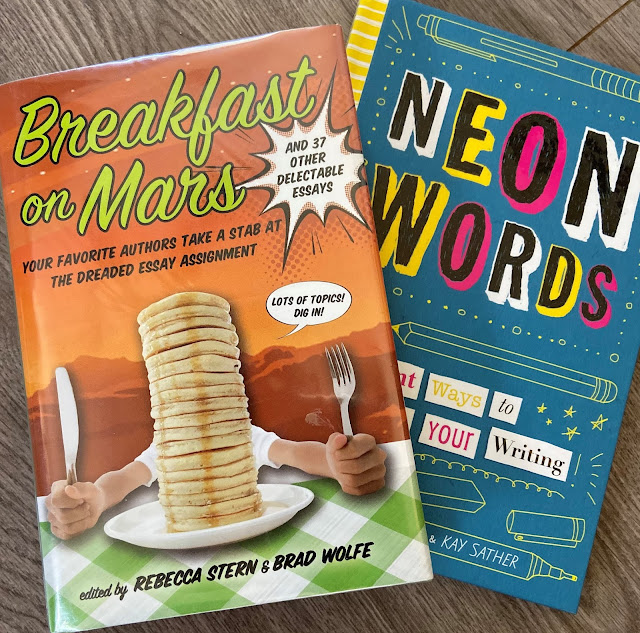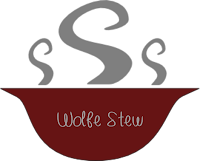Writing as Art
It's time we make writing fun again, and I'm calling on you to help me do it! It breaks my heart that starting in Kindergarten I hear my nephew being prepped on writing the five sentence paragraph with the transitional words first, next, last, in conclusion hammered into him. It's repetitive, redundant, repulsive. We're making our kids dread writing. And writing should be fun!
Last night, the Mr and I went to the library Most of the time I just put books on hold, drop books off, pick up my holds and leave. But last night, I went hunting. I was hunting a book of writing exercises to help me build that muscle. And not only did I find that book, but I also found a book of like-minded leaders who organized essays meant to breathe fun into writing again. I'll be featuring both of these gems on our menu today.
Neon Words
The first book, Neon Words by Marge Pellegrino & Kay Sather is the book I'll be using to train my writing skills. I found it in the kids section. I'm not ashamed. It's fun! Writing should be fun. Good choice on my part.☺️
The first exercise, which I started today, involved sketching a self portrait. At first my heart flopped, (I have to draw?!?) but then I remembered the words of another wise author (whom I'll later address): "Don't judge. Just draw. Give yourself grace in drawing." I'm totally paraphrasing here, but you get the point. Don't be hard on yourself. You can draw. Just focus on one detail at a time. Think of the shape. Study each line. No erasing, (that is the hardest part for me) just re-see when you make a "mistake." Re-interpret it.
So, with these words playing on repeat in my head, pencil hit the paper and I drew myself. Not great. But I did even challenge myself by using my non-dominant hand (at the suggestion of Pellegrino and Sather, I would not have thought to do that on my own). And, I'll admit, the results shocked me. You should try it. Seriously. You can draw too.
Next, I was to write similes that describe me. I did. From my head to my toes. Again, shutting out that critical voice in my head telling me I can't write. I just repeated the wise (paraphrased) words of the other author: "Don't judge. Just write. Give yourself grace in writing."
Words on paper, I next cut out each word. The idea is I'm to rearrange them. Re-see them. Re-interpret them into a poem about me. As I cut, the obnoxious ceiling fan kept blowing my precious words around the room, and then I understood what the authors of Neon Words were trying to communicate:
Hold your words and show them respect. This will give your words and ideas weight, making them touchable, visible and beautiful. (From Neon Words by Marge Pellegrino and Kay Sather)
Oh, I needed to give my words weight alright, so they'd stop blowing around the room! But seriously, I was worried about protecting each precious word as they were flying away. And the one I almost lost and went searching for was "like." Like there weren't a multitude of likes among my pile of once similes. I couldn't lose that one like though, because what if I needed it? That word had weight. It had meaning. It was a gem I couldn't lose.
I envision my words, as I return to the process tomorrow, sprawled across the floor as I work through the process of re-imagining, re-interpreting, revising them into a poetry self portrait.
Fun in writing - that's what it was. I loved it! I can hardly wait to return to it tomorrow. I encourage you to engage your littles in this process, and maybe even do it right along with them. It helps them to see you writing too. Here is an outline of the process for you.
- Draw your self portrait.
- Write similes about yourself.
- Rewrite (or type) the similes larger.
- Cut out each word.
- Rearrange the words (choosing ones that hold value) to form a self portrait poem.
If you think this activity is the kind you would like to do more of with your learners, I encourage you to check out the book, Neon Words by Marge Pellegrino and Kay Sather. Not only do they put fun back into writing, they also break down each activity into three sections.
- Strengthen Your Words.
- Honor Your Words.
- Play with Your words.
When you get the book, don't skip the introduction. It has some compelling reasons to make writing a daily part of your routine. I highly recommend you check this one out!
Breakfast on Mars
The second book, Breakfast on Mars was a splurge book for my niece. (Splurge book? Is there even such a thing at a library?) It caught my eye while trying to find an "adult" writing guide. (Who needs that anyway?) Breakfast on Mars is a compilation of essays by famous authors. (Ashamedly, I recognized one of them, but I'll be adding more to my ever-growing reading list.) Edited by Rebecca Stern and Brad Wolfe, this book fills the need for solid, engaging essay samples for your learner. These editors (like me) are saddened by the redundant, repetitive, repulsive format of essay instruction. Read it in their words:
But, Essay, we must tame you. We must squish you into five paragraphs, and we must give you so much structure that you cower in the corner, scared for your life. (From Breakfast on Mars by Rebecca Stern and Brad Wolfe)
They call for new life to breathe into essay writing. Maybe even for a return to an essay's original purpose - as a trial or an attempt. To help us re-envision essays as "hip" and "provocative" methods of writing instead of redundant and repulsive.
As my 6th grade niece commences the trudge through essay writing trenches, I thought this book might help her find fun in otherwise ghastly circumstances. Maybe it will inspire her. Maybe it will help her understand writing is not meant to be boring, specific, regulated. Writing is an expression of self. Writing is art.
Writing Is Art
I came to this realization, that writing is art, when homeschooling said niece. Our art instruction came from Drawing with Children by Mona Brookes. This book, recommended to me by my art teaching mother, (I love you, Mom!) changed the way I saw art. I had (okay, maybe still have) a fixed mindset, very fixed mindset, cemented mindset, when it comes to art. I just can't do it. I'm not an artist. Even my beloved step-dad says I only draw flies. But, Mona Brookes tackled me to the ground, held me to the floor, and only released me when I saw the the artist in me. I am an artist. You are too. Just work your way through her book, you'll see. Be prepared for tackling though.
So, how did Mona Brookes unlock the artist in me and show me writing is art? It was in her rules and mindset framework for art. In the picture below are 1) Mona Brookes' art rules (revised for our use), 2) Our routine for art set-up, 3) Mona Brookes' art mindset framework (revised by us), and 4) the book.
Each art session began with a set-up and review of the rules and expectations. The rules and expectations slowly seeped into writing. My niece, like many learners today, writes reluctantly. Writing takes work, has rules, expects something, and starts with a menacingly large blank page. It was my task to help her see writing as creativity, as art, as entertainment, as fun. So, halfway through the year, I revised writing. Pictured below are our writing rules, expectations, mindset framework, and primary resource book. (Although, I did also get many ideas from The Art of Teaching Writing by Lucy Calkins.)
Notice anything? No? Compare the art picture to the writing picture. The rules? The remember to's? Yeah, they are intentionally the same. Writing is art. Writing is creative. Writing is fun. We need to return to that!
To help you on this journey, I've created some think sheets that start with art and progress into writing. They are designed to help your learners connect creativity in art to creativity in writing. They'll begin by researching an artwork. Uncovering facts about it. Then, they'll analyze the same artwork artistically. Using their analysis, learners will plan and create an inspired artwork from the researched and analyzed art. Finally, the process repeats with writing. What we do in art creatively, can be mirrored in writing.
I'm glad you agree, leaders. It's past time we put the fun back in writing!
With Love from the Kitchen,
Interested in even more educational resources? Then stop by our Learning Lab. It's here where we store all the educational resources we've cooked up to date.






